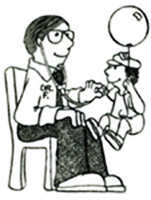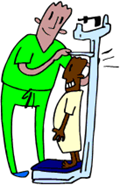

Ivar B. Fandel, M.D., F.A.A.P.
Pediatric and Adolescent Medicine
Diplomate, American Board of Pediatrics
Fine Art Photography & Painting
- American Academy of Pediatrics
- Childhood Development
- Childhood Immunization Schedule
- Travelers' Health Topics
- Sports Injuries
- Fever in children
- Autism in children
- Healthy Eating and Diets
- Save Money on Drugs
- Acne in Teens

Healthy Eating and Diets
- Diets
- South Beach
- Weight Watchers
- Glycemic Index
Many children and adults in this country are overweight or obese. Many diseases and illnesses are associated with obesity, such as heart disease, hypertension, and diabetes. The reason for being overweight is that your body is taking in more calories than it needs.
The calories that go into your body is the food you eat. The calories that you burn up is the exercise you do. If there are more calories going into your body than you burn up, you will gain weight; if there are less calories going into your body than you burn up, you will lose weight. Since the amount of exercise that most people do is pretty constant, the main thing that influences the amount of weight you gain or lose is the number of calories going into your body, or the amount of food you eat.
There are many different diets that exist. They will all work, since they all reduce the number of calories that you consume. Some are based on counting calories and many are based on reducing simple carbohydrates. Probably the first thing to eliminate are sugar containing drinks. In warm climates, it is necessary to consume large amount of liquids. This liquid should be water (which has no calories). Soda is forbidden; it does nothing good for you. Sugar containing drinks such as juice and gatorade also contain large amounts of sugar and calories. Adding sugar to coffee is also not good. Having a high protein, low carbohydrate breakfast helps to suppress your appetite later in the day.
Both South Beach and Atkins diets restrict carbohydrates -- carbs, as diet dilettantes like to say. True, "good carbs" are allowed. But South Beach dieters must say goodbye to potatoes, fruit, bread, cereal, rice, pasta, beets, carrots, and corn for the first two weeks. After that, most of these foods remain strongly discouraged.
Both South Beach and Atkins diets have a more severe induction phase, followed by a long-term eating plan.
The difference, really, boils down to two things:
- Fats. The South Beach Diet bans unhealthy fats but strongly promotes healthy ones.
- Carbs. The South Beach Diet doesn't count grams of carbs. The Atkins diet seeks to change a person from a sugar-burning machine into a fat-burning machine. The South Beach diet looks at how much sugar is in a carb. Low-sugar carbs -- those with a low glycemic index (they don't cause the blood sugar levels to rise and fall as quickly) -- are good (this point may sound very familiar to fans of the Sugar Busters diet)
As Agatston says, this means his diet is not -- exactly -- a low-carb diet or a low-fat diet.
What You Can Eat on The South Beach Diet
You won't go hungry on The South Beach Diet. In fact, like the Body-For-Life diet, The South Beach Diet promotes strategic snacking. You're not doing it right if you don't snack.
There's no counting calories or strict portion sizes. But there's no gorging, either. The idea is to eat normal portions. To many of us, normal portions will seem small at first. They are enough to satisfy hunger, but no more.
As noted above, sugar-rich carbs are off the menu. These include rice and potatoes, and vegetables -- such as beets and corn -- with high sugar content. Also, there are no pastries or other sugar-filled desserts. And alcohol is forbidden in the induction phase and limited in the long-term diet.
What's on the menu? There are three phases.
The 14-day induction phase bans bread, rice, potatoes, pasta, baked goods, and fruit. And you can't have even a drop of beer, wine, or other alcohol. The diet promises that after a couple of days, you really won't miss this stuff. As for dairy, two servings of low-fat or non-fat milk, yogurt, or buttermilk are now allowed during this phase.
What You Can Eat on The South Beach Diet continued...
The "reintroduce the carbs" stage gradually adds back in some of the banned foods. Not all of them, but if you are a pasta maniac, have some. Carrots used to be on the "foods to avoid" list at first, but you can now have them at the beginning of phase two. Tomatoes and onions, previously limited, are now fine in any phase. Fruit makes a comeback, too. Just pick and choose. A little now and then, no more. How long does this last? Until you hit your target weight.
The final stage is your diet for life. Eat normal foods in normal portions, following a few basic guidelines.
Read the book. The first 40 pages explain the principals to follow, which is the important part to remember.
What Is the Weight Watchers Diet?
Since the early 1960s, Weight Watchers has been the gold standard for successful weight loss programs. Among the reasons for Weight Watchers' longevity: the program is based on science, addresses the dieter's lifestyle as a whole, and is free of gimmicks.There have been several versions of the Weight Watchers diet over the last 40 years, but the company's chief scientific officer, Karen Miller Kovach, MS, RD, thinks the latest program -- called "Momentum" -- is the best yet.
"We have combined the point system of tracking intake with a focus on filling foods that are low in energy density but also provide satiety, so you can stick with your plan without gnawing hunger," she says.
"It is an easy-to-follow weight loss plan that can help people stay in control of their eating habits while learning how to eat smarter portions and make healthier, more filling, food choices."
Weight Watchers has always focused on long-term weight management and a commitment to an overall healthy lifestyle. The program is based on four basic principles: eating smarter, moving more, getting support, and developing better habits.
Don't expect to be told what you can and cannot eat on the Weight Watchers diet. Instead, you'll learn strategies to conquer hunger, and follow an individualized, calorie-controlled eating plan that works with your lifestyle.
The Momentum plan highlights foods that are nutrient-rich and filling, but members make the actual choices based on their personal preferences and allotment of points.
"We realized that the point system allowed dieters to eat whatever they wanted and their choices were not always healthy, so we did research to find out how to make every point count and still provide good nutrition while keeping hunger at bay," says Kovach.
Much of Weight Watchers' success is due to keeping members connected to each other and to support staff. Members can get support both online and at meetings that can be found in most communities.
"Being connected is one of the secrets to long-term weight loss success," says Kovach. "When you have to go to a meeting or log in your weight, it serves as a motivator to stay on track."
Weight Watchers' web site includes several useful diet features and tools, including recipes, calorie calculators, restaurant guides, meal trackers, and more.
What You Can Eat on the Weight Watchers Diet
You don't have to eat less, just smarter, on the Weight Watchers diet. No foods are prohibited. Instead, each food is assigned "points" based on its calorie, fat, and fiber content.
Each member has a target Daily Points Range, calculated based on their body weight and activity level.
The points system helps you learn to get more value out of what you eat by making healthier food choices. Some examples:
- 1 cup broccoli: 0 points
- 1/2 cantaloupe: 2 points
- 1 small bean burrito: 5 points
- 1 6-ounce steak: 8 points
- 1 3-ounce grilled chicken breast: 3 points
- 1/4 cup regular creamy salad dressing: 8 points
- 1 slice bread: 2 points
- 1 ounce chocolate: 4 points
- 1 scoop vanilla ice cream: 4 points
The Momentum system also helps members avoid hunger. Filling foods such as popcorn, broccoli, and whole wheat pasta are identified with green diamonds, and dieters are encouraged to eat them.
How the Weight Watchers Diet Works
The new twist to the Weight Watchers Momentum plan is its focus on foods that help keep people feeling fuller longer because they contain plenty of fiber, water, air, and/or lean protein. And of course, the less hungry you are, the less likely you are to raid the cookie jar.
While there's only one eating plan, dieters can opt for in-person meetings at their local chapters or at work, or the online subscription service. Weight Watchers members who go to meetings and use the online suite of diet tools, tips, and trackers lose about 50% more weight than other members.
Originally developed as a tool to help diabetics manage blood sugar control, the glycemic index has found its way into the mainstream weight loss market. The glycemic index is the basis for many popular diet plans, such as SouthBeach, The Zone, Sugar Busters, Glucose Revolution, and Ending the Food Fight.
Specifically, the glycemic index (GI) measures how much a 50-gram portion of carbohydrate raises a person's blood-sugar levels compared with a control (that is, white bread or pure glucose). Virtually all carbs are digested into glucose and cause a temporary rise in blood glucose levels, called the glycemic response. This response is affected by many factors, including the quantity of food; the amount and type of carbohydrate; the cooking method; degree of processing, and more. Each food is assigned an index number from 1-100, with 100 as the reference score for pure glucose. Typically, foods are rated high (greater than 70), low (less than 55) or moderate (56-69).
The glycemic index diet's popularity has been fueled by claims that low-GI foods can help control appetite and weight and may be useful for people with diabetes or pre-diabetes. The idea is that low-GI foods are absorbed more slowly, allowing dieters to feel full longer and making them less likely to overeat.
Dieters are encouraged to choose carbohydrate foods with a low glycemic index, which tend to be (but are not necessarily) healthier, nutrient-rich, less refined, and higher in fiber -- like whole fruits, vegetables, and beans.
In contrast, higher GI foods "trigger a rise in blood sugar, followed by a cascade of hormonal changes, which tend to make you hungry again sooner because they are metabolized quicker than low-GI foods," explains David Ludwig, MD, PhD, author of Ending the Food Fight.
The blood sugar spikes of high-GI foods are especially problematic for people with diabetes because their bodies have trouble regulating blood sugar. The theory that helped launch all the glycemic index diets is this: If it works to help control blood sugar in diabetic people, then it should work for weight control.
Because the GI diet is an approach to weight loss rather than a specific plan, guidance on fats, protein, alcohol, weight maintenance and exercise vary depending on the plan. Ludwig and most GI diet plans also advocate getting regular exercise and eating moderate amounts of lean protein and healthy fats -- similar to the recommendations of the U.S. government's 2005 Dietary Guidelines.
Quality, not quantity, of carbs is the mantra of a glycemic index diet. The idea is to feel fuller by enjoying plenty of low-GI "smart" carbs -- whole grains, whole fruits, vegetables and legumes -- along with lean protein and healthy fats. You'll avoid the high GI foods, which tend to be made with white flour and heavily processed.
But confusion can arise when you check the GI score for a food like carrots, which can range from 16 to 92, or for sugar or candy, which can get a lower score than a potato!
The truth is that a low GI score is no guarantee of healthy fare. Low-GI foods include candy bars (a Snickers scores 55) and potato chips (54). Common sense should warn dieters that these treats are not healthy components of a weight-loss diet. Likewise, there are nutritious, high-GI foods, like corn, baked potatoes and fruit juices, that can certainly be part of a healthy weight loss plan.
Ludwig's plan in particular calls for no calorie counting, just a basic understanding of the principles of the glycemic index or glycemic load (a similar calculation in which the glycemic index is multiplied by three times the amount of carbohydrate in a serving).
"There is a psychological benefit when a dieter is not restricted and allowed to eat to satisfy their appetite with healthy foods," says Ludwig.
Glycemic Diet Index: How It Works
Glycemic index diets have become a popular weight loss tool based in part on the theory that high-GI foods raise blood sugar levels, cause the body to secrete excess insulin, and lead to the storage of fat. Nevertheless, a huge debate exists in the nutrition community about the value of the glycemic index for weight loss.
One of the reasons the glycemic index is controversial is because of the variability of the GI scores, which can be altered by many factors, ranging from ripeness to cooking method.
"The riper a banana, the higher the score," explains Rachel Johnson, PhD, MPH, RD, professor and dean at the University of Vermont. "Al dente pasta is higher than more cooked pasta. Add fat to foods and you can lower the GI, or if a product is made with fructose instead of sucrose or table sugar, it is absorbed more slowly and therefore gets a lower GI score."
The GI response to a given food also varies widely from person to person. It can even vary within the same person from day to day, according to research reported in the June 2007 issue of Diabetes Care.
"We tested the response when an individual ate the same food on three different occasions, and even within the same person, the range in glucose and insulin was huge," says Tufts University's Alice Lichtenstein, DSc, one of the authors of the study.
Nationally known diabetes expert and author Marion Franz, MS, RD, CDE, says the GI numbers don't mean much because the range is tremendous even within the same foods.
"It is hard to know what the glycemic index of a food really is when something like rice can range from a low of 55 to over 100," she says. Further, "there is no difference in the ranking of white and brown rice, or white and whole wheat bread, and clearly whole grain choices are more healthful."
Indeed, the 2005 Report of the Dietary Guidelines Advisory Committee states, "Current evidence suggests that the glycemic index and/or glycemic load are of little utility for providing dietary guidance for Americans."
Franz also takes issue with the actual glycemic index measurements: "The GI does not measure how rapidly glucose levels increase, and studies that compare high- and low- glycemic diets show that the glucose peaks are about the same time" for each, she says.
She explains that blood glucose peaks about the same time with most foods because we rarely eat foods alone, and the addition of fat and/or protein to meals slows down the response time. A high GI-food combined with a low-GI food produces a moderate response.
Still, other experts note there is evidence that eating meals low on the glycemic index can help reduce hunger. In research published in the May 16, 2007, issue of TheJournal of the American Medical Association, Ludwig and colleagues found that foods with lower GI scores seemed to reduce hunger in obese teenage boys.
"The boys were hungrier after they had eaten a high-GI breakfast, which resulted in eating 600 to 700 more calories at lunchtime than when they ate a low GI breakfast," says Ludwig. And boys on a low-glycemic diet lost more weight than other groups in the study.
In the same study, Ludwig and colleagues also found that low-GI diets seemed to be more effective in people whose bodies secrete more insulin. High insulin secreters tend to be "apple-shaped" people who accumulate fat around their waists, rather than those with more lower-body fat or "pear" shapes. He suggests if you are an "apple" who has not done well on other diets, you may succeed with the GI approach.